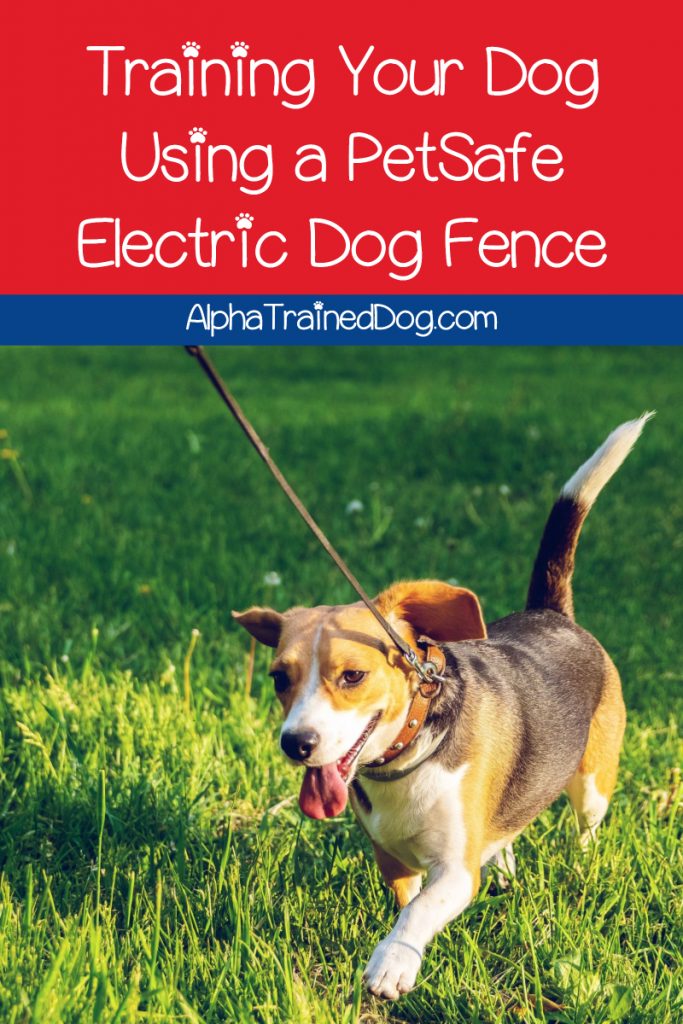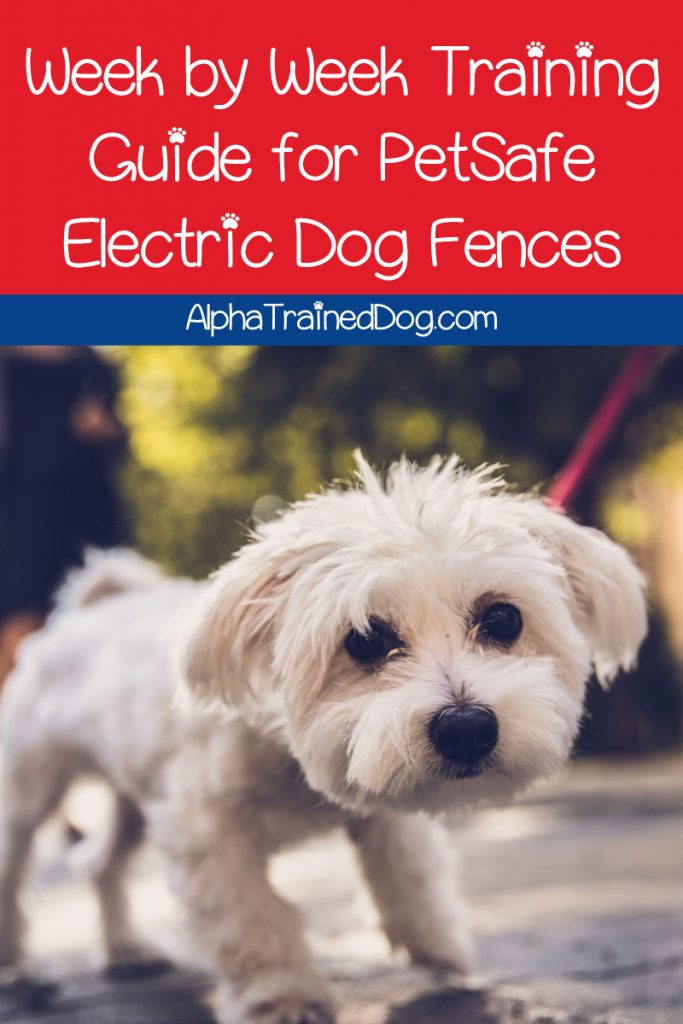Before you start training your dog using a PetSafe Electric Dog Fence, you’ll need to keep a few important things in mind.
Remember, this fence uses negative reinforcement to tell your dog when he’s too close to the boundary.
So, you’ll want to make sure you’re doing everything exactly right all the way through!
Read on for tips on how to make the process as easy as possible for both you and your dog.

Training Your Dog using a PetSafe Electric Dog Fence
Let’s start with a bit of a disclaimer, shall we? Electric dog fences are a grey area when it comes to training.
Personally, we don’t love anything that uses shock technology to teach a dog what not to do.
Reward training is a far better option in just about every case, and I’d rather see you use an actual fence than something that has the potential to fail.
Unfortunately, some of us live in developments where fences aren’t allowed, while others may not have the money to build a giant privacy fence around their entire yard.
So, in those cases, an electric fence can be a good alternative as long as you follow basic guidelines. Read on to find out what they are.
Consistency is key
Once you beging, it is vital to have as few disruptions during your pets’ training sessions as possible.
DO NOT let your dog run around the yard without his collar on.
You’ll only confuse him and may even have to start the whole entire electronic dog fence training process over again.
In fact, it’s smart to keep him on a lead the entire first week. However, be very careful not to take him over the boundary, even on the leash.
This is called “Doorway Training” and we will talk about this later, For now, though, if you need to leave the yard, take the collar off and carry him to the car.
Please, please, please remember to REMOVE HIS ELECTRIC DOG FENCE COLLAR before you take him across the boundary, though.
Get your dog used to the collar
The PetSafe collar takes some getting used to and the probes can actually irritate your dog’s neck, especially at first.
So, after each short session for the first week, remove it. The next three weeks, take it off for one full night once a week.
When you take it off, clean your dog’s neck as well as the probes. You’ll want to do this once every night for the first month.
Soon, he’ll tolerate wearing it all the time.
Use the training flags
The training flags aren’t just decorative. They’re actually there for two reasons.
First, they give your dog a visual cue so he knows when he’s getting close to the boundary. Second, they also help you with the training process.
The flags should be installed about one foot from away from the boundary and remain there for at least 30 days (although it’s perfectly fine to leave them there longer).
Now, let’s take a look at your week-by-week guide to training your dog to use the PetSafe Electric Dog Fence.
Week by week training guide for the PetSafe Electric Dog Fence

First and foremost, remember that dog training should be fun, and not stressful at all.
Also remember, if other family members assist in the training sessions, they must follow the exact same technique.
Make each session short and sweet- ten minutes max. Dog have short attention spans and training can be very tiring for them! Also, don’t get discouraged if he doesn’t “get it” at first – he will eventually learn.
Days 1 to 3
Put a leash on your dog using a slip collar or another type of flat collar. Never put it directly on the PetSafe collar.
Next, turn the dog fence collar to the lowest setting. Remember, your dog needs to learn how to use the flags as cues first.
If you just shock him before he even understands what’s expected, you’ll confuse him at best and give him anxiety at worst.
Walk with your dog inside the boundaries of the yard and praise and play with him. Just have fun together!
Now, move towards the training flags. As he gets close, give a quick command to back off. Some also recommend the “jerk and release” method, but commands are a little more humane.
Soon you should see your dog turn to avoid the flags. This shows that he is learning. Make sure you play with your dog in the containment area to show him time spent in the yard is a pleasant experience.
Remember, keep him on a leash during this first week, even to go outside to the bathroom.
Some dogs will “pick up” the training faster than others.
Before moving on to stage 2, make sure that your dog is happy to run and play in the yard and avoiding the flags.
If not, spend an extra day or two flag training.
Training is simply following the building blocks – you cannot proceed to stage 2 without first completing the flag training.
Training Your Dog using a PetSafe Electric Dog fence – Week 2
During this stage, your dog can now experience the higher correction levels of the dog fence collar.
Walk him within the containment area of the yard and praise him. Let him proceed toward the training flags.
When your dog enters the signal field, he will experience an uncomfortable, but harmless, static correction.
Since this correction may startle your dog, he may jump and yelp. This is normal.
Make sure when this happens, you quickly bring your dog back into the containment area and praise him.
NEVER PULL OR CALL YOUR DOG INTO THE SIGNAL FIELD. Let him decide to enter or stay within the safe area.
Before proceeding to stage 3, be sure your dog is happy to run and play in the safe area of the yard and is avoiding the training flags, if not, spend an extra day or two on stage 2.
Week 3
Now that your dog has successfully completed the first two stages, he is ready to be off the leash while you are constantly supervising him.
DO NOT leave your dog unattended during this phase.
It isn’t uncommon for your dog to associate the training with his leash or you, so he may accidentally leave the yard even with the collar on.
Many times, the dog will run back into the safe area of the yard by himself. If not, go get him, remove his collar and return to the yard.
If you are unable to get to him right away, turn the transmitter off so that he can return without receiving a correction.
After a week of constantly supervising your pet while off the leash, you can start leaving him unattended for short periods of time.
Gradually, over the next week, begin building up the time your dog is left unattended.
It may take a few days before your dog is confident to do so alone. Just take him to the safe area and give him some treats and praise.
Remember, if your dog is not properly and fully trained to the electric dog fence – it will not work.
You cannot move from one stage to the next without being certain that your dog has fully understood the previous stage.
If you are unsure, spend the time to add a few extra days on a stage before proceeding.
Final stage: Doorway training
Once you complete stage three, you can start removing the flags if you want. Take out every other flag each day until they’re all gone.
Then, you can teach your dog how to safely walk over the boundary – this is called “Doorway training”.
Remove the dog fence collar and place him on a leash using a flat or slip collar.
Encourage your dog to follow you by reassuring him and praising him. Most dogs will be reluctant, but you must be persistent.
DO NOT allow your dog to “bolt through” the signal field.
Teach him it is safe to cross with you while he is on a leash. Use a release word such as ” FREE.”
Be consistent and both exit the yard and re-enter it at the same point each time. Eventually your pet will associate the leash with leaving safely.
Remember – these electric dog fences are NOT miracle devices. They also cannot physically contain a dog to the yard.
Your dog must be properly trained to the system (up to 30 days) for the dog fence to work.
If you are hesitant or unsure about training the dog yourself, we recommend consulting a reputable professional trainer who has experience with electronic dog fences.




I have to admit I don’t think I could use this with my dog, although I’m also lucky that he is EXTREMELY motivated by treats! We trained him on recall using a mixture of treats and a 10m ‘gun dog’ lead and it has so far seemed to work. He’s still a little tricksy some days, but we keep a short lead attached to his harness so we can catch him if he runs off (nippy little dog!) and we’ll be gradually shorting it over time as he gets more accustomed to the freedom!
Great for dog owners living in apartment complexes too so they don’t wander beyond allotted space.
Thats a very helpful and informative post. I am sure dog.owners will relate with this post.
I don’t really agree with this type of training. Just like you, I prefer a rewards training instead.
Such a helpful post! Never heard of these electric dog fences, should consult a professional trainer before!
Really detailed post but I feel it has a lot of limits and can be stressful. Reward training is more fun and it’s easier. With an electric fence, it takes extra supervision-not everyone has that time or patience. But in the end, it boils down to preference.
I had not heard of this type of training before. I think I would prefer to use reward training.
I really do not like this type of training. IMO this training doesn’t promote a good relationship between you and your dog. Reward training is much better